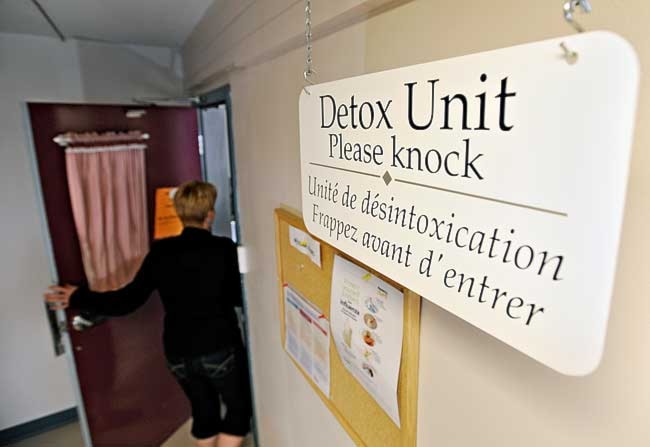The city detox centre was only meant to be a short-term solution for youth looking for a place to sleep at night.
But for some youth, waking up each day in the Sarah Steele Building has become too routine.
One has been sleeping there since February, said Vicki Durrant, executive director of the Youth of Today Society, an organization that provides services to at-risk youth.
“He’s not happy - he gets kicked out each morning at 9 a.m. with all his belongings and can’t go back until 9 p.m.,” said Durrant.
“How can you go to school or look for a job if you have to carry all your stuff with you in a backpack all day?”
The youth in question could only hide his face with his hands when asked about staying at the detox centre.
He was hesitant to give his name or speak to the media. The last time he spoke publicly, the staff at a group home he was living at treated him badly as a result, he said.
Last fall, the Youth of Today Society put forward a proposal to the territorial government to partially fund a 10-bed permanent youth shelter at 410 Jeckell Street.
Health and Social Services Minister Glenn Hart refused the request, saying in a February letter to Durrant that it was not the best use of their “limited resources.”
The government said it would have to first research the issue of homelessness before moving ahead with the idea of a permanent shelter. Until then, they would continue funding temporary shelter services through the Skookum Jim Friendship Centre and the Sarah Steele detox building.
Program funding was only supposed to run until the end of March.
But in April, the government quietly extended funding until March of 2010. It is a decision that didn’t sit well with Durrant.
“I don’t know why the government is putting money towards the detox centre - (the Youth of Today shelter) is a better deal.”
The government will spend $233,000 this year to run its program, which operates each day from 9 p.m. to 9 a.m., said Michelle Boleen of the Yukon Health and Social Services Department.
Funding a permanent shelter with 24-hour care for youth would cost only $200,000 more, said Durrant.
Durrant stares out at the 10 empty beds at 410 Jeckell Street, the facility better known to youth as the Angels’ Nest.
In July, the agency was forced to move its offices and after-school program into the Angels’ Nest for fear of losing the building. It couldn’t afford to make payments on both the Blue Feather building on Second Street and the house at 410 Jeckell.
The society opted to keep the house, hoping the government would eventually change its mind and fund a permanent shelter instead.
Stable care is a necessary component to rehabilitate at-risk youth, said Dalhousie social work professor Michael Ungar, who has done extensive research on homeless youth.
“Continuity of care and attachment to one single place is well proven as a best practice for homeless youth,” said Ungar who visited the Youth of Today Society in 2007.
The work the society does is “world class,” said Ungar, who has studied youth shelters in a dozen different countries.
“Vicki has provided a place where she has successfully engaged marginalized youth, a group that doesn’t tend to engage well,” said Ungar who plans to use The Youth of Today Society as a case study in his forthcoming book.
The amount of money it takes to run a shelter like Angels’ Nest is relatively small, he said.
“The government can pay for it now or it can pay for it for the next 30 years by supporting youth who grow up to be heavy service users.”
But the government says what it is offering now is working, said Boleen.
“The service at Sarah Steele building has provided an effective interim step in responding to concerns raised that there are young adults in Whitehorse who may be experiencing homelessness or are hard to house,” she said.
Durrant pegs the number of homeless youth in Whitehorse at 18 to 20, but the numbers are hard to determine, she said.
When she was running a temporary youth shelter at the Roadhouse in 2007, all 18 of the beds in the facility were filled.
There are only four beds available at the Sarah Steele Building. Additional beds were supposed to be offered through Kaushee’s Place, but the women’s transition home only accepts adult women and children fleeing abusive situations.
If a homeless female youth doesn’t fit that description, she would be turned away, said executive director Barbara McInerney.
In the last year and a half the centre received a little over 300 calls from homeless youth, two-thirds of which were placed at either the Sarah Steele Building or Kaushee’s Place, said Chris Nash, a support worker at the Skookum Jim Friendship Centre.
In August alone the Sarah Steele Building admitted 22 youth, said manager of Alcohol and Drug Services at the Sarah Steele Building, Larry Whitfield.
“The rooms have been heavily used over these last few months,” said Whitfield
Between February 2008 and June 2009, 65 different youth used the temporary shelter services, according to Nash.
The need is clearly there, said Durrant.
She just hopes the government will consider a more permanent option for youth and wonders how much longer youth will be sleeping in the detox centre.
“The government can continue using detox as a shelter, but how can you justify the cost to taxpayers and justify that to the kids on the street?”
Contact Vivian Belik at
vivianb@yukon-news.com
